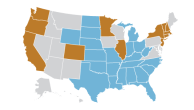The religiously unaffiliated number 1.1 billion, accounting for about one-in-six (16%) people worldwide. The religiously unaffiliated include atheists, agnostics and people who do not identify with any particular religion in surveys. However, many of the religiously unaffiliated have some religious beliefs. For example, belief in God or a higher power is shared by 7% of Chinese unaffiliated adults, 30% of French unaffiliated adults and 68% of unaffiliated U.S. adults. Some of the unaffiliated also engage in certain kinds of religious practices. For example, 7% of unaffiliated adults in France and 2 7% of those in the United States say they attend religious serv ices at least once a year. And in China, 44% of unaffiliated adults say they have worshiped at a graveside or tomb in the past year.10

The religiously unaffiliated are heavily concentrated in Asia and the Pacific, where more than three-quarters (76%) of the world’s unaffiliated population resides. The remainder is in Europe (12%), North America (5%), Latin America and the Caribbean (4%), sub-Saharan Africa (2%) and the Middle East and North Africa (less than 1%).
Although a majority of the religiously unaffiliated live in Asia and the Pacific, only about one-in-five people (21%) in that region are unaffiliated. More than one-in-six people in Europe(18%) and North America (17%) are religiously unaffiliated. The unaffiliated make up smaller shares in the remaining regions. For instance, less than 1% of those who live in the Middle East-North Africa region are unaffiliated.
More than six-in-ten (62%) of all religiously unaffiliated people live in one country, China.11 The largest populations of the religiously unaffiliated outside China are in Japan (6% of all unaffiliated), the United States (5%), Vietnam (2%) and Russia (2%).
There are six countries where the religiously unaffiliated make up a majority of the population: the Czech Republic (76% are religiously unaffiliated), North Korea (71%), Estonia (60%), Japan (57%), Hong Kong (56%) and China (52%).
This report estimates that 16.4% of the total U.S. population (adults and children) was unaffiliated as of 2010. However, recent Pew Research Center surveys found that, as of 2012, 19.6% of U.S. adults are unaffiliated. The different findings reflect both an increase in the percentage of U.S. adults who are religiously unaffiliated and differences between the portion of adults and the portion of children in the U.S. who are unaffiliated. Slightly higher shares of children than adults are estimated to have a religious affiliation.


Median Age
Globally, the religiously unaffiliated are older (median age of 34) than the overall global population (median age of 28). Among the five regions for which data are available, sub- Saharan Africa has the youngest population of religiously unaffiliated people (median age of 20), followed by Latin America and the Caribbean (26), North America (31) and Asia and the Pacific (35). Europe has the oldest unaffiliated population, with a median age of 37.
Median ages of the religiously unaffiliated differ from the general population in each of the major regions for which data are available. In two regions, the religiously unaffiliated are older than the general population: Asia and the Pacific (where the unaffiliated median is 35 years and the general population median is 29 years) and sub-Saharan Africa (20 vs. 18). In three regions, the religiously unaffiliated are younger than the general population: North America (unaffiliated 31 years; general population 37 years), Europe (37 vs. 40) and Latin America and the Caribbean (26 vs. 27).

Footnotes:
10 Beliefs and practices of unaffiliated adults in the United States are documented in the Pew Forum’s October 2012 report “ ‘Nones’ on the Rise.” The Pew Forum’s belief-in-God question measures belief in God or a universal spirit. French results are based on a Pew Forum analysis of 2008 International Social Survey Programme (ISSP) data; the ISSP survey measures belief in God or a “higher power of some kind.” Chinese results are based on a Pew Forum analysis of the 2007 Spiritual Life Study of Chinese Residents survey, conducted by the Chinese polling firm Horizon. In China, the belief-in-God statistic includes belief in God, gods, spirits, ghosts or Buddha. (return to text)
11 China, the world’s most populous country, also is home to a majority of followers of folk or traditional religions (73%) and Buddhists (62%). (return to text)




